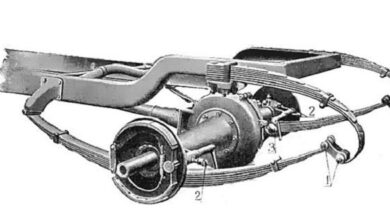Transmission systems – The gearbox and gear ratios

Reason for a gearbox
The internal-combustion engine used in modern vehicles will operate over a limited effective speed range, for example, 1500–7000 rpm, producing a comparatively low torque (turning effort). If the speed drops below the lower limit, or if the load is too great, the engine will stall and the vehicle will come to rest. If a vehicle did not have a gearbox, the following disadvantages would soon become apparent.
Poor acceleration from rest
The clutch would have to be slipped for a considerable time to avoid stalling the engine. A road speed of about 24 kph (15 mph) would have to be reached before a full engagement could take place, and during this time the driving force at the wheels (tractive effort) would only be slightly greater than the force opposing the motion of the vehicle (tractive resistance). The acceleration is governed by the difference between tractive effort and resistance. If this difference is small, the acceleration will be poor.
Poor hill-climbing ability
A gradient increases the resistance and this will mean that as soon as a hill is tackled, the engine will slow down and eventually stall. This could be overcome by employing a large engine with a high torque output, but it would be uneconomical.
The vehicle cannot be driven at low speeds
As the vehicle speed is decreased, the engine speed will also be decreased. Slipping of the clutch would be necessary to avoid stalling if the vehicle had to be driven at low speeds.
No neutral or reverse
It would not be possible to keep the vehicle stationary without stalling, so the clutch would always have to be disengaged when the vehicle wasn’t moving. This also makes the vehicle difficult to manoeuvre.
Gear leverage
When the person applies effort without a lever, there is no sufficient force to provide forward motion. When using the lever and pivoting this at the bumper, the person is able to produce forward motion due to the duplication in force through the length of the lever. Indeed, the length of the lever provides a multiplication of force applied from the same amount of effort from the person.
Other mechanical devices are able to produce similar results, although not necessarily using levers. Components such as gears can provide a multiplication of force from a given input. Figure 3.3a shows another simple form of lever using weights and pulleys. The force applied to the end of the lever utilising weight m and pulleys can lift a weight four times as great (weight M). This simple experiment shows that a small input force can be amplified using the lever system.
Determination of gear ratios
Obtaining a high maximum vehicle speed, combined with good acceleration and economy over the whole speed range, requires a system of gearing that allows the engine to operate at the speeds at which it develops its best performance. Maximum engine power, torque and economy all occur at different engine speeds, so this makes the task of matching the gear ratio difficult, especially when variable operating conditions and driver demands have to be taken into account.
Maximum vehicle speed
Maximum vehicle speed is achieved when the vehicle is set in its highest gear and the throttle is held fully open. To minimise friction losses in the gear that is used most of the time, a ratio of 1: 1 (direct drive) is chosen for ‘top gear’. Consequently, the setting of ‘top gear’ is really the choice of a final-drive ratio to suit the diameter of the road wheel and engine characteristics. It shows the balance between the power required and the power available. Data for the former is given by the brake power curve of the engine; for the latter, data is obtained by calculating the power needed to overcome the tractive resistance of the vehicle when it is moving along a level road.
Last word
In a gearbox fitted with six gears, fi fth normally would have a 1 : 1 ratio with sixth being an overdrive because it has a ratio that steps up the speed; as a result, it drives the output shaft faster than the engine.




